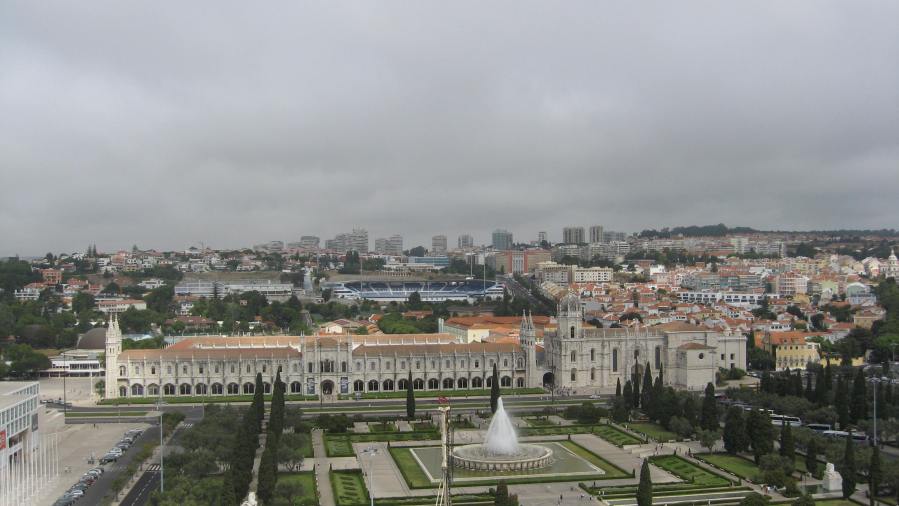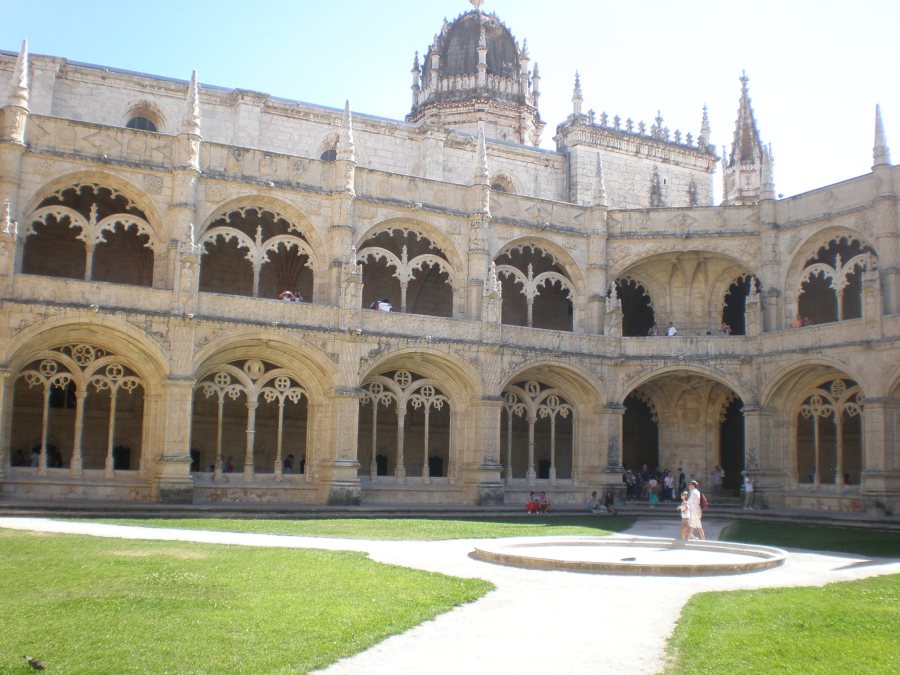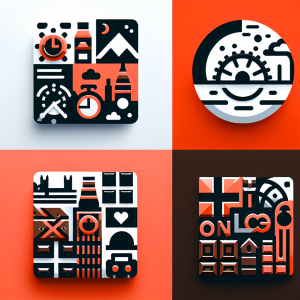
On the second day of our honeymoon in Lisbon we took the tram no.15 from Praça da Figueira to Belém area. Unfortunately it wasn’t one of those old-fashioned rickety trams but a new one which was very crowded. Still, I enjoyed the long ride along the river Tagus from the center of Lisbon to Belém which is famous for several historic landmarks namely the Tower of Belém and the Jerónimos Monastery. It was cloudy but during the day the sun emerged from under the clouds and we got sun-burnt! I had planned to take a sun cream on this trip but I simply forgot so we bought one later in the center to prevent future sunburns.
We got off the tram at the grandiose Jerónimos Monastery but we first visited almost equally impressive Monument to the Discoveries. This enormous monument at the waterfront was built in 1960 to commemorate the 500th anniversary of the death of Portuguese prince Henry the Navigator who sponsored many expeditions. It was under his patronage that Portugal founded its first colonies and the Age of Discoveries began. The monument represents a caravel (ship) and it celebrates not only Henry the Navigator but many Portuguese heroes associated with the Age of Discovery such as explorers, cartographers, artists, missionaries, kings etc. We walked around it and then entered and decided to take a lift up the viewpoint. We had discount because of our Lisbon card which gave us free public transport and many free entrances. From the top of the monument we saw the Tower of Belém which looked small in comparison (the Monument to the Discoveries is 52 m high), the monastery, Belém cultural center, a football stadium and the beautiful red bridge (Ponte 25 de Abril ) that resembles the Golden Gate bridge in San Francisco, USA and the Christ statue which is a smaller twin of the Christ statue in Rio de Janeiro, Brasil. When we got down we walked across the huge pavement compass rose and world map; a gift from the Republic of South Africa. Since it was already getting hot I needed a refreshment in the form of ice-cream (I had mulberry flavour) so that I could walk to the romantic Tower of Belém.


After only two days in Portugal I started to notice that some Portuguese words resemble some English and French words and that most tourists we saw/overheard where either from Brasil (Portugal’s former colony) or France. There was a queue on the wooden draw bridge to get in the tower but we didn’t wait for too long in the end. The Tower of Belém was built in 16th century as a fortress to safeguard the mouth of the Tagus river and I would add to impress the newcomers who sailed to Lisbon. It was built in the characteristic Portuguese Manueline style ( a mixture of late Gothic and Moorish and other styles) named so after the King Manuel I. The tower is a UNESCO World Heritage Site because of its significant role in Portuguese maritime discoveries.
I was in awe of this fortress that to me looked so romantic that I could just imagine a princess looking out to the sea waiting for her beloved to return to her loving arms. We explored the tower thoroughly from the austere storerooms and dungeons and canons to beautifully carved watchtowers and battlements. I’m amazed at the skill of the old craftsmen who could make such beautiful decorations out of the hard stone to make it look like it’s lace. We climbed the narrow steps to the terrace on the top ( it was like climbing in the lighthouse) to take in the view of the river and Belém area. For the first time ever I saw a small traffic light (arrows) which indicated who could go up and who could go down on the narrow stairway to the top which is a brilliant idea. However, people being people not everyone obeyed the rules and there were still a couple of squeeze situations. I learned in the tower that the first image of rhinoceros in Europe is a small statue of a rhinoceros on this tower because the Portuguese brought a rhinoceros back from Africa. They didn’t bring back a live animal of course but a taxidermic one who apparently sank with the ship which had brought it.

the first representation of rhinoceros in Europe!
Straight ahead of the tower is a military museum and some kind of a war memorial. As usual my husband wanted to get in the empty sentry box so that I could take his photo and as usual he was yelled at /warned by the soldiers who stood near in the watch. I don’t know why he does it. I guess I should be lucky that he didn’t get some sort of a fine already.
So, we got back to the magnificent Jerónimos Monastery which is also a UNESCO World Heritage Site. Firstly, we did the Archaeological museum which is situated in the west wing of the monastery and then we saw the church and the stunning refectory and the cloister. In the museum we gawked at the Egyptian’s mummies and Roman statues and lots of gold because everything was written just in Portuguese language. In the church we saw the tomb of Vasco da Gama who was the first European to reach India by sea. There were also tombs of several Portuguese royals. The church was quite impressive but the really spectacular part for me were the refectory and the cloister. I felt like I was suddenly transported to a Harry Potter movie. Can you believe that humble monks and priests lived surrounded by such splendor for centuries? The intricacies of the masonry design is unbelievable! The monastery was largely financed by profits made from the spice trade (pepper) in the early 16th century.


All this beauty made me very hungry and what better place to satisfy my sweet cravings than one of the oldest cake shops in Lisbon, the Antiga Confeitaria de Belem ? Of course, we had to try Pastéis de Belém-a typical Portuguese egg tart pastry. There was a queue outside as long as half the street but as I’m curious and slightly impatient I went to the front of the queue to take a peek inside and then I realized that this queue was for the people who ordered take away while you could normally enter the cake shop and eat at the table. And that’s what we did 🙂
I found us a table and ordered the sweet pastéis de Belém (also known as pastéis de nata) which were first made by the monks of the Jeronimos monastery. At the time of extinction of many religious orders and the closing of the monasteries they sold the recipe for this sweet goodness to the nearby sugar refinery whose owners later opened this cake shop. It’s still a family run business and all the cakes are made at the premises. I loved Pastéis de Belém and you can sprinkle some sugar or cinnamon on it. We had them later also at our hotel’s breakfast but they weren’t as big or as good as they were at this cake shop. Since we spent too much time munching on our pastries we missed visiting the National Coach Museum which closed just minutes before our arrival at its doors.
We went back to the center by bus and rested a bit at our hotel. Later in the evening we went out for a dinner. Every evening we found a different small restaurant where we had great meal. I was surprised by the cheapness of eating out in Lisbon. All of our meals were delicious and all the wine we had was also reasonably priced and of good quality. I won’t write restaurants or hotels reviews here because I had already written them on TripAdvisor long before I started this blog. After our dinner we strolled again to the magnificent square Praça do Comércio where we saw a sign advertising a light show at the square at 11 pm. So, we waited around for it and weren’t disappointed when it started. There were several lasers and different lights that projected images onto the left wing of the former royal palace at the square. The images showed different landmarks of Lisbon which were accompanied by music. The best part for me was when the building seemed to be crumbling right in front of your eyes or when you saw a big plane and later a shark coming out of the building. This show was an excellent ending of our second day in Lisbon.
Ps. Stay tuned for more Lisbon posts! I hope you’ve already read my first
Follow my travels Facebook // Bloglovin’ // Twitter // Google+
Ps2. My blog is already two months old and I’m so happy to see it grow gaining followers and more views and comments and likes every day!:) Big thanks to all of you who have read my posts! 🙂
This post is also available for offline reading and free download as a travel article app. If you choose to upgrade (to get GPS navigation) I’ll receive a small commission. Thank You! To get the app click here.











[…] Challenge. There will be 10 mysterious photos, so 7 more to go. Last challenge was a photo from Lisbon, Portugal. Congratulations to all who guessed it right! Sarah and Matteo were the first who guessed […]
LikeLike
[…] Lisbon, Portugal […]
LikeLike
[…] distance from my hometown to a place, then the furthest place I’ve ever travelled would be Lisbon , Portugal which is over 2 000 km from my hometown and which was definitely the longest flight […]
LikeLike
[…] Lisbon, Portugal […]
LikeLike
[…] I did my pre-trip research and I knew I had to go there. So when my husband and I visited Belém area famous for Belem tower, the Monument to Discoveries and Jeronimos monastery we just had to […]
LikeLike
[…] most popular blog posts in 2015 were: BRUSSELS (April 2015), Exploring Belém-Lisbon (Sep 2014), My favourite things about travel (Travel Link Up), The festive season in Nice (France), A cat […]
LikeLike
[…] two years ago I spent my honeymoon in Lisbon. It was a wonderful week! We also visited Sintra region and Evora. I’d like to go back to […]
LikeLike
Ahaa, its nice conversation regarding this post at this place
at this website, I have read all that, so at this time me also commenting
here.
LikeLike
OK:)
LikeLike
[…] Have you visited Sintra? What about fado? Have you listened to it? Check out my other Lisbon posts ( here, here, here and here ). […]
LikeLike
Wonderful photos again!
LikeLiked by 1 person
I add this: You wrote: “After only two days in Portugal I started to notice that some Portuguese words resemble some English and French words and that most tourists we saw/overheard where either from Brazil (Portugal’s former colony) or France.”
Pronouncing Portuguese in Portugal or in Brazil, there is huge difference. I have learnt Brazilian Portuguese in Finland as You see in my 4 language posts.
LikeLike
🙂
LikeLike
Thank you
LikeLike
Belem looks beautiful, those pasties look delish!
Would love for you to come linkup with us at http://www.outsidesuburbia.com/os-inspirations/outsidesuburbia/outside-suburbia1/
LikeLiked by 1 person
Thanks, I’ll check it out!:)
LikeLike
Wow – what a lot to see! Last year, I got out-voted on going to Portugal…you can bet I’m making everyone read this post so I can say “told you so!” 😉 Looks like you had a fabulous trip – thanks for sharing it on #MondayEscapes!
LikeLiked by 1 person
It was a great trip, and this isn’t all. I need to write more posts:)
LikeLiked by 1 person
Heehee… If there’s more like this, then yes you do! 😉
LikeLiked by 1 person
ok 🙂
LikeLike
I can see why you felt like a princess on top of the tower! It’s stunning. Love the story of the rhino. Interesting fact I never knew! Lisbon looks like a wonderful city. Thanks for linking up with #MondayEscapes
LikeLiked by 1 person
Thank you!:) Lisbon’s really beautiful! I’ve got more posts about it to publish:)
LikeLike
Oh wow! What a bunch of pretty places. Great honeymoon choice. Hope I can make it to Lisbon one day.
LikeLiked by 1 person
:)Thanks!
LikeLike
Welcome to the blogging world, for 2 months only you’re doing amazingly well! I don’t think I got a comment other than from my mum for at least 6 months!!! I absolutely love pastéis de nata and keep reading about the originals from Belem and know I must get there soon.
LikeLiked by 1 person
Thank you! Well, actually most of my friends still don’t know about my blog:) SHHh! The pasteis de belem are so delicious!
LikeLike
I also thought Portugal was a pretty cheap destination compared to the Northern part of Europe that is. :p Congratulations on the 2nd monthsary of your blog! 🙂
LikeLiked by 1 person
Thank you!:)
LikeLike
Ugh I am DYIIING to go to Lisbon! Such a great read!! #MondayEscapes
LikeLiked by 1 person
Thanks! it’s a wonderful city!
LikeLike